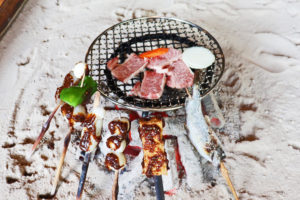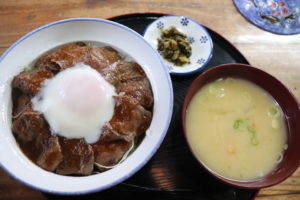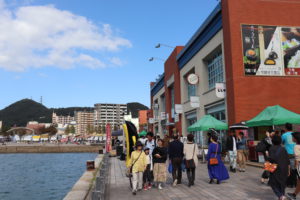Akaushi don
Akausi don is this rice bowl is made with luxurious Aso red beef called Akaushi raised
in the nature of the magnificent green grasslands of Aso, Kumamoto-prefecture,
and allows you to easily enjoy the delicious flavor of the beef.
Slices of Akaushi steak grilled medium-rare are laid luxuriously on top of the rice.
When you stuff your mouth with Akaushi rice and meat, you will experience an
indescribable bliss, and it is an irresistible dish for meat lovers.
 |
 |
 |
Takamori dengaku
Takamori dengaku is the local cuisine in Aso, which a dish created to make the sweet potatoes,
which can only be grown in this region, more delicious and last longer.
As part of Takamori’s culinary culture, it has remained the same since then, with the addition
of some ingredients.What we are particular about is that the condiments in Dengaku miso
are exposed to the sun and contain a lot of minerals that have been absorbed, making it
a dish that not only fills your stomach but also maintains your health by eating it.
We hope you will enjoy Aso with traditional slow food while sitting around the hearth,
coating the ingredients grilled over natural charcoal with miso, and talking with others.
 |
 |
 |
 |
 |
 |
Omura sushi
A local dish that has been passed down in Omura since ancient times.
During the ancient time, when feudal lord Omura Sumikore, who had been
defeated in battle and had his territory taken away, fought back and regained
his territory, the people of his territory made pressed sushi and served it to
celebrate.
 |
 |
 |
It is said to have originated. The reason why it was pressed sushi was because
there weren’t enough tableware to feed a large number of soldiers. It is said that
the people spread large quantities of freshly cooked rice in a shallow wooden
box and quickly made pressed sushi with double toppings, which the soldiers
then ate by cutting it into squares with a wakizashi. Due to this tradition, the locals
have called it “Omura sushi, which means sushi to celebrate winning battles,
” and it is still valued as an indispensable dish for celebrations.
Yobuko fresh Squid, in Yobuko, Saga
Famous for fresh Squid, transparent in body and firm in texture. The squid has a sweetness that melt
upon the tongue. In the finely crafted style of sashimi known as Ikezukuri, the flesh of still-living
seafood is served.
 |
 |
 |
Saga beef
Saga beef is esteemed as one of the best Wagyu beef brands in Japan. The cattle used for our
meats are fattened in adherence to the regulations of the Japan Agriculture Co-operative, and
we use only Japanese black cattle registered with their cattle traceability system.
 |
 |
 |
Aso Akaushi beef rice bowl
Aso Akaushi laterally means red beef that is unique in that it has a higher proportion of red meat
with just the right amount of fat, combined with great taste, tenderness and healthiness. Aso Akaushi
beer rice bowl is a local cuisine in Aso consisting of a bowl of rice put in a mildly sweet sauce and
topped with Akaushi beef and egg.
 |
 |
 |
Yaki curry, 焼きカレー
Yaki curry is a local cuisine in Moji, Kitakyushu-city.
Yaki curry latterly means baked curry and is curry with rice topped with cheese and/or egg
heated in oven. The melted cheese and soft-boiled egg
combine with the spicy curry to enhance its flavor even more.
 |
 |
 |
Kawara Sobe, 瓦そば
Kawara soba is a local cuisine which Soba noodles and meat are cooked together on a Kawara
(stone roof tile) and dipped into a special sauce when eating it. It is said that the hints were
obtained from the time when during the Seinan civil war in 1877, soldiers of Satsuma who
surrounded the Kumamoto castle used kawara (stone roof tiles) to cook wild plants and meat.
 |
 |
 |
It is said that the hints were obtained from the time when during the Seinan civil war in 1877,
soldiers of Satsuma who surrounded the Kumamoto castle used kawara (stone roof tiles) to
cook wild plants and meat.
Okonomiyaki, お好み焼き
A dish made of wheat flour batter with eggs, vegetables, meat, seafood, noodles, and other
desired ingredients added to it and grilled on a griddle. Eat with a special sauce, green
seaweed, and dried bonito flakes.
 |
 |
 |
There are different types of okonomiyaki depending on the region, such as Kansai-style
okonomiyaki, in which ingredients are mixed into the batter and baked, and Hiroshima-style
okonomiyaki, in which noodles and other ingredients are layered in the batter.
Starbucks at Dazaifu Shrine approach path
Coffee break under the traditional atmosphere. The restaurant was designed by renown
architecture designer Kengo Kuma in 2011. The concept of the design is Harmony of
Modern and traditional by natural material; 2000 cedar timber is assembled in a traditional
wood structure without using nails. Enjoy the luxurious time in the warmth of wood and the
scent of coffee.
 |
 |
 |
